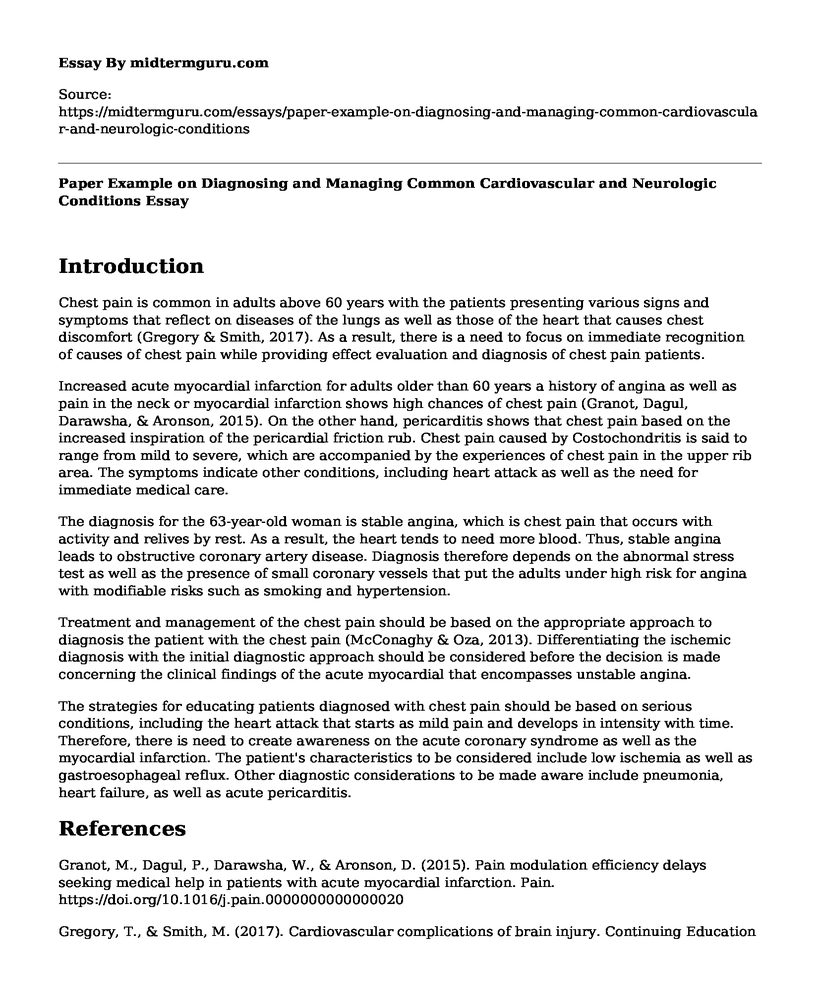Introduction
Chest pain is common in adults above 60 years with the patients presenting various signs and symptoms that reflect on diseases of the lungs as well as those of the heart that causes chest discomfort (Gregory & Smith, 2017). As a result, there is a need to focus on immediate recognition of causes of chest pain while providing effect evaluation and diagnosis of chest pain patients.
Increased acute myocardial infarction for adults older than 60 years a history of angina as well as pain in the neck or myocardial infarction shows high chances of chest pain (Granot, Dagul, Darawsha, & Aronson, 2015). On the other hand, pericarditis shows that chest pain based on the increased inspiration of the pericardial friction rub. Chest pain caused by Costochondritis is said to range from mild to severe, which are accompanied by the experiences of chest pain in the upper rib area. The symptoms indicate other conditions, including heart attack as well as the need for immediate medical care.
The diagnosis for the 63-year-old woman is stable angina, which is chest pain that occurs with activity and relives by rest. As a result, the heart tends to need more blood. Thus, stable angina leads to obstructive coronary artery disease. Diagnosis therefore depends on the abnormal stress test as well as the presence of small coronary vessels that put the adults under high risk for angina with modifiable risks such as smoking and hypertension.
Treatment and management of the chest pain should be based on the appropriate approach to diagnosis the patient with the chest pain (McConaghy & Oza, 2013). Differentiating the ischemic diagnosis with the initial diagnostic approach should be considered before the decision is made concerning the clinical findings of the acute myocardial that encompasses unstable angina.
The strategies for educating patients diagnosed with chest pain should be based on serious conditions, including the heart attack that starts as mild pain and develops in intensity with time. Therefore, there is need to create awareness on the acute coronary syndrome as well as the myocardial infarction. The patient's characteristics to be considered include low ischemia as well as gastroesophageal reflux. Other diagnostic considerations to be made aware include pneumonia, heart failure, as well as acute pericarditis.
References
Granot, M., Dagul, P., Darawsha, W., & Aronson, D. (2015). Pain modulation efficiency delays seeking medical help in patients with acute myocardial infarction. Pain. https://doi.org/10.1016/j.pain.0000000000000020
Gregory, T., & Smith, M. (2017). Cardiovascular complications of brain injury. Continuing Education in Anaesthesia Critical Care & Pain, 12(2), 67-71. https://doi.org/10.1093/bjaceaccp/mkr058
McConaghy, J. R., & Oza, R. S. (2013). Outpatient diagnosis of acute chest pain in adults. American Family Physician.
Cite this page
Paper Example on Diagnosing and Managing Common Cardiovascular and Neurologic Conditions. (2022, Sep 12). Retrieved from https://midtermguru.com/essays/paper-example-on-diagnosing-and-managing-common-cardiovascular-and-neurologic-conditions
If you are the original author of this essay and no longer wish to have it published on the midtermguru.com website, please click below to request its removal:
- Essay Sample on Aristotle's Virtue Ethics and Its Application to the Problem of Abortion
- Sugary Drinks Linked to Stroke Risk: Study Findings - Essay Sample
- Baby Pram Breaks, Kylie's Nanny in the Line of Fire - Case Study
- Tailor-Made Solutions: Healthcare Professionals Embrace Case Management for Diabetes - Essay Sample
- Nurses Lead Self-Care Revolution - Research Paper
- Sinusitis: Understanding the Inflammation of the Sinuses - Essay Sample
- Genetic Improvement for Disease Resistance in Salmonid Species - Annotated Bibliography







